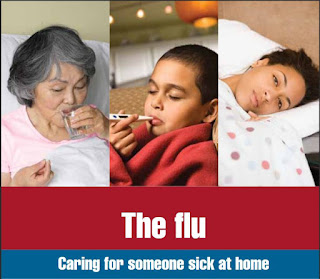 |
| Credit CDC - PDF Guide |
#12,786
Even though it is still only late September, we are already beginning to see scattered reports of seasonal influenza across the country - easily a month earlier than usual. A few headlines from the past 24 hours (excluding the swine variant outbreak in Maryland) include:
Officials urge influenza vaccination as Colorado sees early uptick in hospitalizations - The Denver Channel
Doctors say flu season is starting earlier than usual - kgw.com ·Portland OR
An Early Start To The Flu Season | Husker Radio - Nebraska
No children under 12 allowed on Children's Hospital patient floors starting Oct. 1 - Birmingham AL
While seasonal influenza's peak may still be months away, it is not too early to get the flu shot - it takes two weeks to kick in - and to start taking winter flu hygiene (covering coughs, washing/sanitizing hands, staying home when sick) seriously.
We've seen a good deal of speculation over what kind of flu season the Northern Hemisphere can expect after the recent particularly rough flu epidemics in Australia, Hong Kong, and Southern China (see UK: NHS Warns Of A Potentially Rough Flu Season Ahead), although in truth, flu is not easily predicted.
What we do know is that H3N2 appears to be the dominant subtype right now, and years where H3N2 dominates tend to be more severe - particularly for those over the age of 65. We also know we are coming off two relatively moderate flu seasons (see chart below), and acquired community immunity may be a bit low.
 |
| Credit CDC FluView |
Despite our fixation with novel flu viruses, plain old seasonal flu kills as many as a half million people each year, and its severity can vary by more than 10-fold from one year to the next ( see MMWR: Estimates Of Yearly Seasonal Influenza Deaths). From that 2010 report, we get estimates for the United States.
For deaths with underlying pneumonia and influenza causes (the most narrow definition of flu-related fatalities used) the models estimated a yearly average of 6,309 (range: 961 in 1986--87 to 14,715 in 2003--04) influenza-associated deaths.Seasonal flu viruses are also capable of picking up enhanced virulence due to small evolutionary changes (see EID Journal: Emergence of D225G Variant A/H1N1, 2013–14 Flu Season, Florida and When Influenza Goes Rogue), sometimes resulting in pockets of more severe disease around the world.
Using a broader criteria (underlying respiratory and circulatory causes including pneumonia and influenza causes) the models estimated an annual average of 23,607 (range: 3,349 in 1986--87 to 48,614 in 2003--04) influenza-associated deaths.
Simply put, the severity of the flu that arrives in Chicago or Miami this winter may differ greatly from what arrives in London, Moscow, or even Los Angeles.A few years ago the Census bureau reported that 1 in 4 households had just a single occupant - greater than at any time in the past century.
Currently, more than 32 million Americans live alone (see chart below), and while many of those are younger people who are waiting later to get married, a side effect of our longer lifespan and high divorce rate is that many of these single households are held by those over the age of 65.
Whether we live alone by choice or by happenstance, we all share a common vulnerability. If we get sick, or injured, there may be no one around to notice, or to help.
As a paramedic I saw a significant number of people who lived alone who either died, or spend miserable hours or even days incapacitated and unable to call for help, due to an illness or accident.Another vulnerable group are households with only 1 adult, and minor children. This too is a growing demographic, with more than 5 million households falling into that category. If the adult falls seriously ill, then even more are potentially at risk.
Because of this, starting in 2007 I floated the idea of having `flu buddies' - someone you can call if you get sick, who will then check on you every day (by phone or in person), fetch food or medicines for you, and who can call for medical help if your condition deteriorates.
While I originally envisioned this for a pandemic scenario, it is just as valid and equally important for those who live alone during regular flu seasons.While we all hope this year's flu season won't be anything out of the ordinary, we can do things now - like getting the flu shot, practicing good flu hygiene, and being and having one or more `flu buddies' - to reduce the impact should things turn out differently.
